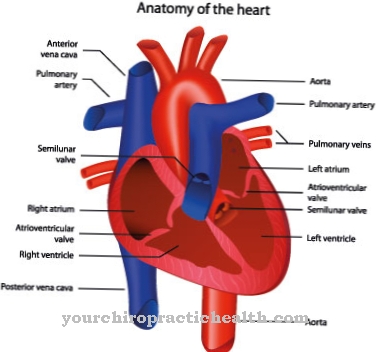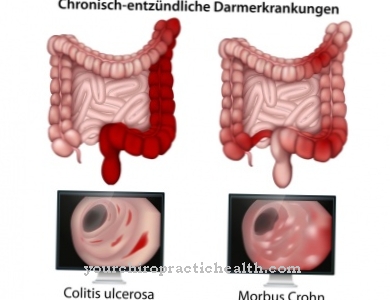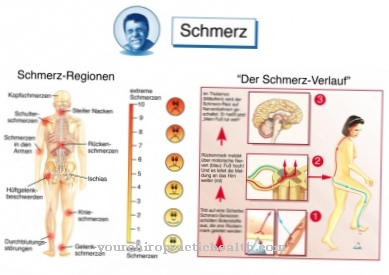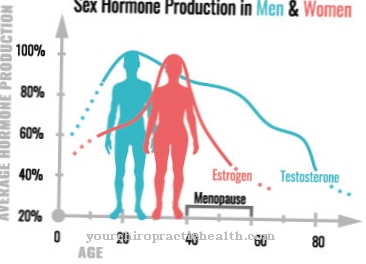A Wasp sting is usually painful but harmless. It only becomes problematic for allergy sufferers. The wasp venom can trigger an anaphylactic shock in them, which in the worst case can be fatal.
What is a wasp sting?

Wasps belong to the group of insects, more precisely to the hymenoptera. They live together in large states and are spread all over the world. Like hornets and bees, wasps have a poisonous sting with barbed hooks that can easily penetrate human skin.
If they feel threatened or disturbed, they stab and inject the poison into the skin, causing swelling, redness and pain. A wasp sting is usually painful, but harmless. Wasp stings only become dangerous after several hundred stings.
However, people with wasp allergies can develop more severe symptoms, which in the worst case scenario can be dangerous even with a single wasp sting. Anaphylactic shock can be life threatening. Wasp stings in the mouth and throat area can also be dangerous because the airways can swell.
causes
Wasps sting when they feel disturbed or threatened. Since they do not disdain human food such as cakes or sausages, especially in late summer, they seek to be close to people and are often very intrusive.
Windfalls are also eaten by wasps with preference, so that many wasps can also be found on the ground in late summer and autumn. In contrast to bees, wasps can sting any number of times and inject poison into the wound. Therefore, they are more aggressive and sting faster than bees. If the wasp venom gets into the human skin, it causes redness, swelling and pain.
How strong the reaction is depends on the amount of poison and the puncture site and is therefore very different. In allergy sufferers, the immune system reacts excessively to the poison that has penetrated and triggers a reaction that can range from slight general reactions or increased swelling to anaphylactic shock.
Symptoms, ailments & signs

A wasp sting causes a burning pain at the puncture site. However, depending on how much poison was injected, it can subside after a few minutes. Usually the reaction is strongest around two to three days after the wasp sting.
The wasp venom is life-threatening for humans only after several hundred stings, and yet a single sting can lead to a life-threatening situation, especially for allergy sufferers. The main symptom of a wasp sting is severe itching around the puncture site and significant swelling.
Anyone who is allergic to the wasp's venom should consult a doctor immediately. In these patients, a wasp sting can not only be accompanied by severe swelling and reddening, but also shortness of breath and shortness of breath or severe circulatory problems are common symptoms. Under certain circumstances, anaphylactic shock can occur, which is accompanied by a racing heart and / or unconsciousness and can even lead to death.
Under certain circumstances it can happen that the wasp's sting is still in the puncture site. Unlike bees, wasps do not lose their sting. It may be possible that only one wasp stings several times.
Diagnosis & course
Diagnosing a wasp sting is usually made through direct observation. If there is no allergy, a wasp sting is comparatively harmless. The skin around the stab site hurts and swells.
The swelling is often most severe on the second or third day and only subsides after a few days. A wasp sting is usually not dangerous. The poison is not strong enough to actually be dangerous to humans. The situation is different for people with wasp venom allergy. They show a much stronger reaction in the first hours after the bite (usually very early).
Severe swelling, headache, nausea or extensive skin reactions are possible. If anaphylactic shock occurs, it becomes life-threatening. With this circulatory shock, the blood pressure drops so massively that vital organs are no longer adequately supplied with blood. Complete circulatory failure and death can result if life-saving medication is not given quickly.
Complications
In most cases, a single wasp sting, while uncomfortable and painful, is harmless and rarely leads to complications. The situation is different if the wasp accidentally gets into the mouth with a drink and stings in the mouth or throat. The sting quickly swells the tissue in the airways and causes life-threatening shortness of breath.
If medical help is not given within a very short time, there is a risk of death from suffocation. The risk of complications increases with the number of stitches. Children can be more sensitive than adults. It is advisable to remain calm around wasps and not to lash out wildly because they are more likely to sting when they feel threatened.
Wasp stings are particularly dangerous for people who are allergic to the wasp venom. One prick can be enough to trigger life-threatening anaphylactic shock. If someone reacts to a wasp sting with dizziness, shortness of breath, feelings of oppression and a racing heart, an emergency doctor must be called immediately.
People who know they are allergic should always carry an emergency kit with them so that they can react quickly in an emergency. An emergency doctor should always be called in the event of shock.
When should you go to the doctor?
In most cases, a wasp sting is not a reason to see a doctor. It heals on its own within a few days or a week and the initial pain is uncomfortable but harmless. The redness and swelling are also nothing to worry about.
However, people who are allergic to wasp venom should notify an emergency doctor immediately if symptoms other than swelling and pain at the puncture site appear after the sting. This also applies if the symptoms are weak. Finally, the symptoms, including those affecting the circulatory system and breathing, can worsen in allergy sufferers some time after the bite. Even people who do not have a known wasp venom allergy but show symptoms of one should consult a doctor.
Wasp stings that do not heal should also be assessed by a family doctor or a dermatologist. Stings in sensitive parts of the body, such as the eye or the throat, sometimes require medical treatment. However, this depends on how bad the pain and swelling is after the bite.
Treatment & Therapy
An ordinary wasp sting should be cooled as quickly as possible to keep the swelling down and relieve the pain. Emergency medication must be given immediately in the event of an allergic reaction.
Usually three different drugs are used depending on the severity: antihistamines, corticosteroids and adrenaline. These medicines are contained in what is known as an emergency kit, which allergy sufferers should have prescribed by their doctor and which they should always carry with them. If severe allergic reactions occur or if adrenaline has to be injected from the emergency kit, emergency medical treatment is necessary. If there are signs of shock (e.g. sweating, nausea and a flat pulse), the patient should be lying down with his legs raised.
This allows the blood to run from the legs back to the upper part of the body, where the vital organs are located. In the long run, the risk of an allergic reaction to wasp venom can be reduced by immunotherapy. Over a period of three to five years, the immune system is repeatedly confronted with tiny amounts of the allergy-causing wasp venom in order to get used to it.
prevention
The risk of a wasp sting can be reduced by taking certain precautionary measures. Aggressive movements such as wagging or hitting the wasps should be avoided. Allergy sufferers should take further precautionary measures, for example not consuming sweet beverages or sweet foods outdoors, avoiding windfalls and possibly avoiding long skirts or wide sleeves so that wasps cannot get caught there. In addition, allergy sufferers should always have an emergency kit with them. This is prescribed by the doctor and can save life in anaphylactic shock.
Aftercare
It is very important for people with an allergy to wasp venom to stay away from these insects as much as possible. Be careful, especially in late summer, when the wasps are particularly active. Grilled meat, sweet foods, and sweet drinks are very attractive to these insects. Allergy sufferers should therefore be extremely careful when eating outdoors.
It is also advisable to stay away from waste bins in public spaces such as swimming pools, parks or rest areas. In order to actively ward off wasps, simple home remedies often help: wasps find the smell of lemon or orange slices studded with cloves to be extremely unpleasant. Tomato plants, lavender and basil also have a deterrent effect on the insects.
Inside the house, insect nets attached to the windows help to protect yourself from the wasps. People with a known wasp allergy should not leave the house without an emergency kit in summer. There are three medications in the emergency kit: An antihistamine, which causes swelling to swell quickly and reduces the allergic reaction; a cortisone preparation, which also has a decongestant effect, and an adrenaline pre-filled syringe, which stabilizes the circulatory system if necessary. Those affected should definitely familiarize themselves with these medications in advance so that in an emergency, a wasp sting can be treated within a few minutes.
You can do that yourself
A home remedy for relieving pain, swelling, and redness after a wasp sting is cooling. An ice cube can help. A cooling pad that is placed on the puncture site for a few minutes is also suitable. Human saliva is also suitable as an immediate measure after a bite; it has a disinfectant effect.
Sugar, which is given to the affected area, has a similar effect. Half an onion or a little lemon juice have anti-inflammatory effects and reduce further skin irritation. Alternatively, garlic can also be used. If you want to remove the fresh poison to avoid swelling, use a clean cloth with hot water and press it lightly on the skin.
Basically, every home remedy needs to be clean and free of debris to avoid infection or further swelling. The same applies to the hands, which are thoroughly disinfected before each treatment.
Essential oils are another home remedy for treating a wasp sting on your own. Peppermint oil cools the skin and disinfects the puncture site, tea tree oil reduces any existing swelling. Clove oil will help reduce the itchiness. Essential oils can cause allergic skin reactions and should therefore only be tested in small quantities on another skin area. If there is severe itching or skin irritation, this home remedy is not suitable for treating a wasp sting yourself.


.jpg)
.jpg)









.jpg)

.jpg)
.jpg)











.jpg)